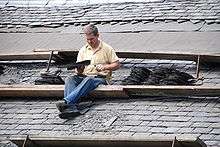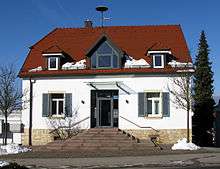Roof pitch




In building construction, roof pitch is a numerical measure of the steepness of a roof. Roofs may be functionally flat or "pitched".
Description
The pitch of a roof is its vertical rise divided by its horizontal span (or "run"), what is called "slope" in geometry and stair construction, or the tangent function in trigonometry. In the imperial measurement systems it is typically expressed with the rise first and run second. In the USA, the run is denominated by the number 12, giving a ratio of how many inches of rise or fall there are to each 12 inches (one foot) of run. For example, 3:12, 4:12, 5:12, and so on. Countries which use metric measurement systems use a degree angle, or what fall there is per unit of run, and expressed as a "1 in x" slope, a 1 in 1 slope being 45°. Where convenient, the LCMs are used, e.g. a 3 in 4 slope, rather than "9:12) or "1 in 1 1/3".
The pitch matters for a variety of reasons including the type of roofing material used, walkability, proportions to the building as a whole which is sometimes a critical factor in some architectural styles such as a steep pitch in Gothic architecture and a low pitch in Classical architecture,[1] and combinations of pitches form distinctive roof shapes such as a gambrel roof. The basic ranges of pitch are not uniformly defined but range from flat, which are not perfectly flat but sloped to drain water up to 1/2:12 to 2:12 ( 1 in 24 to 1 in 6); low-slope roofing requires special materials and techniques to avoid leaks and ranges from 1:12 (2:12)[2] to 4:12 (1 in 3);[2] conventional from 4:12 (1 in 3) to 9:12 (3 in 4);[2] and steep-slope roofing is above 9:12 (3 in 4)[2] (21:12) (7 in 4) and may require extra fasteners.
US convention is to use whole numbers when even (e.g. "three in twelve") or the nearest single or two-digit fraction when not (e.g. either "five and a quarter in twelve" or "five point two-five in twelve", each expressed numerically as 5.25:12).
Definitions vary on when a roof is considered pitched. In degrees, 10°[3] (2 in 12 or 1 in 6) is considered a minimum.
The exact roof slope in degrees is given by the arctangent. For example: arctan(3/12)=14.0°
The primary purpose of pitching a roof is to redirect water and snow. Thus, pitch is typically greater in areas of high rain or snowfall. The steep roof of the tropical Papua New Guinea longhouse, for example, sweeps almost to the ground. The high, steeply-pitched gabled roofs of northern Europe are typical in regions of heavy snowfall. In some areas building codes require a minimum slope. Buffalo, New York and Montreal, Quebec, Canada, specify 6 in 12, a pitch of approximately 26.6 degrees.
Carpenters frame rafters on an angle to "pitch" a roof. Gable and other multi-pitched roofs allow for lower primary structures with a corresponding reduction in framing and sheathing materials.
Historical pitches

Historically roof pitch was designated in two other ways: A ratio of the ridge height to the width of the building (span)[4] and as a ratio of the rafter length to the width of the building.[5]
Commonly used roof pitches were given names such as:-
- Greek: the ridge height is 1/9 to 1/7th the span (an angle of 12.5° to 16°);
- Roman: the ridge height is 2/9ths to 1/3 the span (an angle of 24° to 34°);
- Common: the rafter length is 3/4 the span (about 48°);
- Gothic: the rafters equal the span (60°); and
- Elizabethan: the rafters are longer than the span (more than 60°).[5]
See also
References
- ↑ "Pitch" Sturgis, Russell. A dictionary of architecture and building: biographical, historical, and descriptive. New York: The Macmillan Co. ;, 1901. 152. Print.
- 1 2 3 4 "Slope" def. 1. Schmid, Karl F.. Concise encyclopedia of construction terms and phrases. New York: Momentum, 2014. Print.
- ↑ Dictionary of Architecture & Construction, C.M.Harris.
- ↑ "Pitch" def. 24.c. Oxford English Dictionary Second Edition on CD-ROM (v. 4.0) © Oxford University Press 2009
- 1 2 "Pitch" def. 2. Knight, Edward Henry. Knight's American mechanical dictionary: being a description of tools, instruments, machines, processes, and engineering; history of inventions; general technological vocabulary; and digest of mechanical appliances in science and the arts.. vol. 2. New York: J.B. Ford and Co., 1874. 1719. Print.